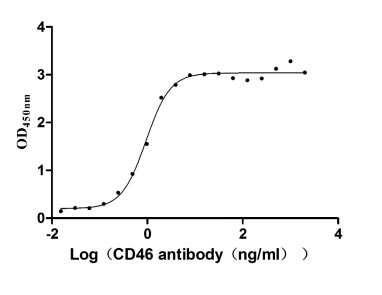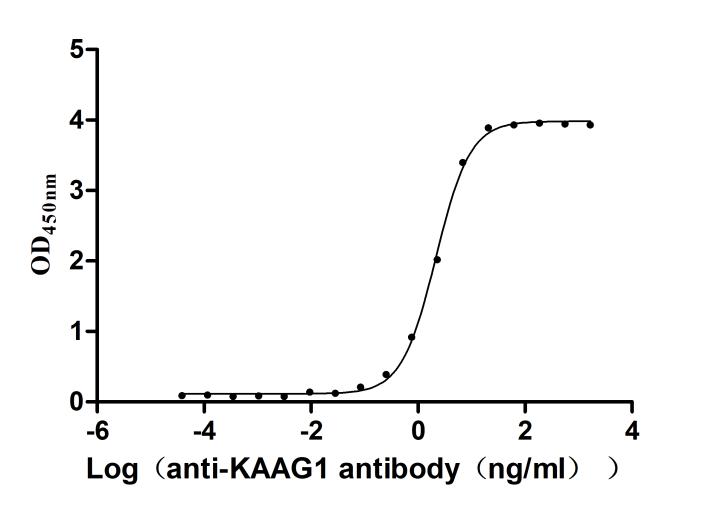Recombinant Mouse Baculoviral IAP repeat-containing protein 3 (Birc3)
-
中文名称:Recombinant Mouse Baculoviral IAP repeat-containing protein 3(Birc3),Yeast
-
货号:CSB-YP002704MO
-
规格:
-
来源:Yeast
-
其他:
-
中文名称:Recombinant Mouse Baculoviral IAP repeat-containing protein 3(Birc3),Yeast
-
货号:CSB-EP002704MO
-
规格:
-
来源:E.coli
-
其他:
-
中文名称:Recombinant Mouse Baculoviral IAP repeat-containing protein 3(Birc3),Yeast
-
货号:CSB-EP002704MO-B
-
规格:
-
来源:E.coli
-
共轭:Avi-tag Biotinylated
E. coli biotin ligase (BirA) is highly specific in covalently attaching biotin to the 15 amino acid AviTag peptide. This recombinant protein was biotinylated in vivo by AviTag-BirA technology, which method is BriA catalyzes amide linkage between the biotin and the specific lysine of the AviTag.
-
其他:
-
中文名称:Recombinant Mouse Baculoviral IAP repeat-containing protein 3(Birc3),Yeast
-
货号:CSB-BP002704MO
-
规格:
-
来源:Baculovirus
-
其他:
-
中文名称:Recombinant Mouse Baculoviral IAP repeat-containing protein 3(Birc3),Yeast
-
货号:CSB-MP002704MO
-
规格:
-
来源:Mammalian cell
-
其他:
产品详情
-
纯度:>85% (SDS-PAGE)
-
基因名:
-
Uniprot No.:
-
别名:Birc3Baculoviral IAP repeat-containing protein 3; EC 2.3.2.27; Cellular inhibitor of apoptosis 2; C-IAP2; Inhibitor of apoptosis protein 1; mIAP1; RING-type E3 ubiquitin transferase BIRC3
-
种属:Mus musculus (Mouse)
-
蛋白长度:Full length protein
-
表达区域:1-600
-
氨基酸序列MVQDSAFLAK LMKSADTFEL KYDFSCELYR LSTYSAFPRG VPVSERSLAR AGFYYTGAND KVKCFCCGLM LDNWKQGDSP MEKHRKLYPS CNFVQTLNPA NSLEASPRPS LPSTAMSTMP LSFASSENTG YFSGSYSSFP SDPVNFRANQ DCPALSTSPY HFAMNTEKAR LLTYETWPLS FLSPAKLAKA GFYYIGPGDR VACFACDGKL SNWERKDDAM SEHQRHFPSC PFLKDLGQSA SRYTVSNLSM QTHAARIRTF SNWPSSALVH SQELASAGFY YTGHSDDVKC FCCDGGLRCW ESGDDPWVEH AKWFPRCEYL LRIKGQEFVS QVQAGYPHLL EQLLSTSDSP EDENADAAIV HFGPGESSED VVMMSTPVVK AALEMGFSRS LVRQTVQWQI LATGENYRTV SDLVIGLLDA EDEMREEQME QAAEEEESDD LALIRKNKMV LFQHLTCVTP MLYCLLSARA ITEQECNAVK QKPHTLQAST LIDTVLAKGN TAATSFRNSL REIDPALYRD IFVQQDIRSL PTDDIAALPM EEQLRKLQEE RMCKVCMDRE VSIVFIPCGH LVVCKDCAPS LRKCPICRGT IKGTVRTFLS
-
蛋白标签:Tag type will be determined during the manufacturing process.
The tag type will be determined during production process. If you have specified tag type, please tell us and we will develop the specified tag preferentially. -
产品提供形式:Lyophilized powder
Note: We will preferentially ship the format that we have in stock, however, if you have any special requirement for the format, please remark your requirement when placing the order, we will prepare according to your demand. -
复溶:We recommend that this vial be briefly centrifuged prior to opening to bring the contents to the bottom. Please reconstitute protein in deionized sterile water to a concentration of 0.1-1.0 mg/mL.We recommend to add 5-50% of glycerol (final concentration) and aliquot for long-term storage at -20℃/-80℃. Our default final concentration of glycerol is 50%. Customers could use it as reference.
-
储存条件:Store at -20°C/-80°C upon receipt, aliquoting is necessary for mutiple use. Avoid repeated freeze-thaw cycles.
-
保质期:The shelf life is related to many factors, storage state, buffer ingredients, storage temperature and the stability of the protein itself.
Generally, the shelf life of liquid form is 6 months at -20°C/-80°C. The shelf life of lyophilized form is 12 months at -20°C/-80°C. -
货期:Delivery time may differ from different purchasing way or location, please kindly consult your local distributors for specific delivery time.Note: All of our proteins are default shipped with normal blue ice packs, if you request to ship with dry ice, please communicate with us in advance and extra fees will be charged.
-
注意事项:Repeated freezing and thawing is not recommended. Store working aliquots at 4°C for up to one week.
-
Datasheet :Please contact us to get it.
靶点详情
-
功能:Multi-functional protein which regulates not only caspases and apoptosis, but also modulates inflammatory signaling and immunity, mitogenic kinase signaling and cell proliferation, as well as cell invasion and metastasis. Acts as an E3 ubiquitin-protein ligase regulating NF-kappa-B signaling and regulates both canonical and non-canonical NF-kappa-B signaling by acting in opposite directions: acts as a positive regulator of the canonical pathway and suppresses constitutive activation of non-canonical NF-kappa-B signaling. The target proteins for its E3 ubiquitin-protein ligase activity include: RIPK1, RIPK2, RIPK3, RIPK4, CASP3, CASP7, CASP8, IKBKE, TRAF1, and BCL10. Acts as an important regulator of innate immune signaling via regulation of Toll-like receptors (TLRs), Nodlike receptors (NLRs) and RIG-I like receptors (RLRs), collectively referred to as pattern recognition receptors (PRRs). Protects cells from spontaneous formation of the ripoptosome, a large multi-protein complex that has the capability to kill cancer cells in a caspase-dependent and caspase-independent manner. Suppresses ripoptosome formation by ubiquitinating RIPK1 and CASP8.
-
基因功能参考文献:
- These data reveal how, upon XIAP deficiency, a TLR-TNF-TNFR2 axis drives cIAP1-TRAF2 degradation to allow TLR or TNFR1 activation of RIPK3-caspase-8 and IL-1beta. This mechanism may explain why XIAP-deficient patients can exhibit symptoms reminiscent of patients with activating inflammasome mutations. PMID: 28723569
- These results reveal an additional level of regulation of the stability and the activity of E2F1 by a non-degradative K63-poly-ubiquitination and uncover a novel function for the E3-ubiquitin ligase cIAP1. PMID: 28542143
- Drugs targeting XIAP and cIAP1/2 may be effective for osteosarcoma patients whose tumors express abundant RIPK1 and contain high levels of TNFalpha. PMID: 27129149
- downregulation of cIAPs in PSC cholangiocytes may contribute to the development of the disease. Our results also indicate that inhibition of TRAIL signaling pathways may be beneficial in the treatment of PSC PMID: 28055006
- We show that BIRC3 has a unique role in facilitating glioma progression from low- to high-grade PMID: 27074575
- These findings reveal a novel mechanism that endotoxin tolerance reprograms mitogen-activated protein kinase signaling by suppressing Pellino 1-mediated K63-linked ubiquitination of cIAP2, K48-linked ubiquitination, and degradation of TRAF3. PMID: 27377744
- Birc3-deficient mice are resistant to azoxymethane-sodium dodecyl sulfate-induced colitis-associated colorectal cancer. PMID: 26037070
- c-IAP ubiquitin protein ligase activity is required for 4-1BB signaling and CD8(+) memory T-cell survival. PMID: 26096449
- Induction of cIAP2 expression upon microglia activation prevents the conversion of caspase-3 p19 subunit to p17 subunit. PMID: 25501826
- we show that cIAP1 regulates TNF-induced actin cytoskeleton reorganization through a cdc42-dependentpathway PMID: 24276241
- cIAP2 (Birc3)-dependent antagonism of RIPK3-mediated programmed necrosis critically protects the host from influenza infection through maintenance of pulmonary tissue homeostasis. PMID: 24439895
- cIAP-2 protects cardiac fibroblasts from oxidative damage: an obligate regulatory role for ERK1/2 MAPK and NF-kappaB. PMID: 23837962
- these results show that the loss of cIAP1 protects skeletal muscle from the degenerative pathology resulting from systemic loss of dystrophin. PMID: 23184147
- a molecular mechanism for cIAP1's regulation in the NOD2 signaling pathway PMID: 23109427
- TWEAK, cIAP1, and noncanonical NF-kappaB signaling has roles in the regulation of myoblast fusion PMID: 23074266
- NFATc1 mRNA expression is negatively regulated by inhibitor of apoptosis protein 1 during osteoclastogenesis. PMID: 23126497
- cIAP2 expression protects macrophages from Rip1-dependent necroptotic cell death and facilitates pathogen control. PMID: 22576661
- found that, despite extensive backcrossing into a C57BL/6 background, c-IAP1(-/-) animals are also deficient in caspase 11 PMID: 22332634
- Our data demonstrate a novel effect of overexpressed BCL10 in the pathogenesis of high-grade MALT lymphoma by increasing expression of API2 and it then forming a protein complex with BCL10/caspase-8 leading to caspase-8 activity suppression. PMID: 21954216
- Deficiency in cIAP1 (encoded by Birc2) or cIAP2 (Birc3) impaired caspase-1 activation after spontaneous or agonist-induced inflammasome assembly. PMID: 22195745
- Data show that inhibitor-induced rapid degradation of cIAPs requires binding to TRAF2, and reveal an unexpected difference between cIAP1 and cIAP2. PMID: 21331077
- one of the functions of cIAP1 when localized in the nucleus is to regulate E2F1 transcriptional activity. PMID: 21653699
- cIAP1 protein protects cells from TNF-induced necrosis by preventing formation of the RIP1- RIP3-FADD necrosome. PMID: 21052097
- Smac mimetics activate the E3 ligase activity of cIAP1 protein by promoting RING domain dimerization PMID: 21393245
- In TNF-stimulated cells, RIPK1 promotes cell survival by stabilizing TRAF2 and cIAP1, which limits induction of non-canonical NF-kappaB and activation of caspase-8.( PMID: 21339290
- fundamental role for cIAP1/cIAP2 in regulating B-cell survival and responsiveness PMID: 21300983
- Data suggest that the c-IAP2/MALT1 fusion protein activates NF-kappaB by two distinct mechanisms, and loss of c-IAP2 E3 activity in vivo is sufficient to induce abnormalities common to MALT lymphoma. PMID: 21048983
- These findings identify critical role of cIAP1, cIAP2 and Yap1 co-expression in mammary carcinogenesis PMID: 20676140
- TNF signaling, but not TWEAK (TNF-like weak inducer of apoptosis)-triggered cIAP1 (cellular inhibitor of apoptosis protein 1) degradation, requires cIAP1 RING dimerization and E2 binding PMID: 20356846
- IAP1 is an ubiquitin protein ligase mediating ubiqitination of IAP2 and its subsequent degragation. PMID: 15798218
- cIAP2 is critical in the maintenance of a normal innate immune inflammatory response. PMID: 16382159
- Results showed distinct patterns of cIAP2 expression during embryogenesis PMID: 16699955
- These results demonstrate that overexpression of IAP-2 renders the heart more resistant to apoptosis and ischemia/reperfusion injury. PMID: 17321613
- c-IAP1 and c-IAP2 are required for TNFalpha-stimulated RIP1 ubiquitination and NF-kappaB activation. PMID: 18621737
- murine cells lacking XIAP and c-IAP 2, but not c-IAP1, exhibit heightened apoptotic sensitivity to both intrinsic and extrinsic apoptotic stumuli. PMID: 18684108
- either cIAP1 or 2 is required for proper Rip1 polyubiquitination and NF-kappaB activation upon TNFalpha treatment PMID: 18697935
- disruption of ubiquitin-conjugating enzyme binding, or dimerization, stabilizes IAP proteins against IAP antagonists in vivo PMID: 18784070
- PERK activity inhibits the ER stress-induced apoptotic program through the induction of cellular inhibitor of apoptosis (cIAP1 and cIAP2) proteins PMID: 19029953
- MMP13 expression enhances osteosarcoma cell survival and Birc2 and Birc3 enhance cell survival but only in osteosarcoma cells with the chromosome 9A1 amplicon. The genes Birc2 and Birc3 are potential oncogenic drivers in the chromosome 9A1 amplicon. PMID: 19276372
- lts show that TAK1 deletion facilitates TRAIL-induced cell death by activating caspase through ROS and downregulation of cIAP, and inhibition of TAK1 can be an effective approach to increase TRAIL sensitivity. PMID: 19421137
- cIAP1 and cIAP2 are E3 ubiquitin ligases that are required for receptor-interacting protein 2 ubiquitination and for nucleotide-binding and oligomerization signaling. PMID: 19464198
- TRAF2 has anti-apoptotic signaling roles in addition to promoting NF-kappaB signaling and that efficient activation of NF-kappaB by TNFR1 requires the recruitment of cIAP1/2 by TRAF2. PMID: 19815541
显示更多
收起更多
-
亚细胞定位:Cytoplasm. Nucleus.
-
蛋白家族:IAP family
-
数据库链接:
KEGG: mmu:11796
STRING: 10090.ENSMUSP00000013949
UniGene: Mm.2026
Most popular with customers
-
Recombinant Human Membrane cofactor protein (CD46), partial (Active)
Express system: Mammalian cell
Species: Homo sapiens (Human)
-
Recombinant Human C-C chemokine receptor type 8 (CCR8)-VLPs (Active)
Express system: Mammalian cell
Species: Homo sapiens (Human)
-
Recombinant Human Serotransferrin(TF) (Active)
Express system: Mammalian cell
Species: Homo sapiens (Human)
-
Recombinant Human Dipeptidase 3(DPEP3), partial (Active)
Express system: Mammalian cell
Species: Homo sapiens (Human)
-
Recombinant Human Kidney-associated antigen 1(KAAG1) (Active)
Express system: E.coli
Species: Homo sapiens (Human)
-
Recombinant Human Interleukin-12 receptor subunit beta-1(IL12RB1),partial (Active)
Express system: Mammalian cell
Species: Homo sapiens (Human)
-
Recombinant Human Mucin-13(MUC13),partial (Active)
Express system: yeast
Species: Homo sapiens (Human)



















